Creative Work
Dr. Les Walkling - Fifteen Years Creating with EIZO
Dr. Les Walkling is an artist, educator and consultant. With too many accolades to list, Les is the former Program Director of Media Arts at RMIT University, and Senior Research Fellow and Australian Research Council Discovery Project grant recipient in the School of Art. His work is held in public collections including The Metropolitan Museum of Art (New York), the National Gallery of Australia, the Art Gallery of NSW and the National Gallery of Victoria. Les is a leading provider of photographic education, and digitization consultant to Australia's cultural institutions. The EIZO Gallery collection was personally curated by him.

What was your first EIZO monitor, and what are you using now?
My first EIZO monitor was the ColorEdge CG220, their first Adobe RGB Gamut monitor. Shortly thereafter we bought the ColorEdge CG221, the first Adobe RGB monitor with digital equalization uniformity (DUE). 12 years on, we still use this on our main profiling workstation where we create the highest quality profiles for people’s printing, pre-press and camera calibrations. I still trust that monitor with my life, and it has been on that workstation for 12 years. Unlike the newer ColorEdge monitors, I have to physically calibrate it and it is still within specification! Today we also use a ColorEdge CG277 and a CG248-4K for video, and we are in the process of adding a ColorEdge CG319X.
What was your initial experience like?
At first glance, the ColorEdge CG220 was mind-bogglingly brilliant. There was a fine difference in the level of detail we were able to see of our work, and it was just what we needed. 15 years running we still use it in our video editing suite as a secondary monitor.
What amazes me is that you buy photographic lenses for long-term applications knowing you’re going to upgrade the camera bodies on a regular basis. Similarly, we’ve gone through many computers, but they have all been plugged into the same EIZO monitor.

How well do the monitors calibrate, and integrate with your existing equipment?
The monitors are extremely workflow-centric and fit in seamlessly. Unlike other equipment, my monitor doesn’t tell me how to work. Instead, it facilitates my work. Be it an extreme like representing an iPad, or a highly fluorescent pre-press standard with insane levels of fluorescence on paper and press to get skin tones and ethnicities correct, and it self-calibrates automatically to mimic those standards. Once I’ve established the parameters and profiles for all of our outputs, armed with ColorNavigator 7.1, they’re simultaneously updated. If you know the basics, just enter the parameters and allow it to work its magic. It turns on at 8.30 am, before we get into the studio, and it’s already verified itself. I can tick that box before I’ve even started working. Given the complexity of calibrating printers, scanners, cameras, there’s nothing easier that I know of than the hardware calibration of a ColorEdge. If only the other tools of my workflow were this accommodating and flexible like my EIZO monitors…

How important is your EIZO monitor to your overall digital color workflow?
We invest in EIZO monitors because of what they enable us to do in our production. What they enable us to see. Seeing is knowing, and knowing enables you to make a difference. As a photographer, you draw the world with the democracy of the lens. It is the monitor that enables us to see the minute details that the camera captures. Accurate “seeing” is what it is all about for a visual artist. They are more than just monitors. They intrude in the most wonderful way on our very sense of ourselves, our very being, and how we make those most critical assessments – aesthetic, political and historical judgements - with our imagery and what we’re trying to do in this world of contemporary art. They are extraordinary devices.

What are your experiences with EIZO’s after-sales service?
The after-sales service is legendary here. I remember, I was scheduled to conduct a workshop in Kununurra, Western Australia. I had an EIZO monitor shipped to the location to be part of my demonstration. Unfortunately, on the 4,000 km journey, it was damaged. I was stranded with no monitor for my workshop. Just to try my luck, I notified the EIZO team. While it took me 2 days to get to Kununurra, my replacement monitor reached me within 24 hours! I have heard similar stories of the team’s exceptional service while helping others set up their EIZO monitors too. There is no other brand that can speak of this level of support.
Tell us about your visit to the EIZO Headquarters in Kanazawa, Japan
My visit to the EIZO headquarters was off the back of my first trip to Japan. So, I was already beside myself with their remarkable culture. The highlight of my visit to the headquarters was the manufacturing area – I saw the production line where my EIZO ColorEdge CG220 was born. To top if off, I cross-checked my monitor’s serial number and met the person who did the final human quality check on my monitor!

What left the most indelible stamp on me was not just the humility, and kindness, and the incredible welcome we received, but that the monitors are meticulously checked by human beings in white gloves, before they are ticked and allowed to be packaged. Despite the science, technology and instrumentation in the building, the extraordinary emotional depth of their engagement with each monitor was mind-boggling. There was a devotion, a pride, and execution that seemed “above and beyond”. This stuff leaves a real impression, not in just how to do things but that idea of perfection and excellence, and the commitment to doing better today than yesterday. This culture within the Japanese culture is phenomenal. To this day, I’ve told these stories regularly. Those who have been to Japan get it. Those who don’t, appreciate it when we work with the monitors.

This stuff leaves a real impression, not in just how to do things but that idea of perfection and excellence, and the commitment to doing better today than yesterday. This culture within the Japanese culture is phenomenal. To this day, I’ve told these stories regularly. Those who have been to Japan get it. Those who don’t, appreciate it when we work with the monitors.
What advice would you give to up-and-coming photographers?
We are in a time where the opportunities that exist in photography are being transcended beyond our wildest imagination. Everything is evolving to be screen-based. The ubiquity of screens used to be the ubiquity of photography. For up and coming photographers who are up to their eyeballs with new ways of thinking about imaging and reality, this is a golden era. At the center of this evolution is our screen. It’s the rebirth of photography with augmented reality, virtual reality etc. And, our morality of the uses of that technology are developing hand in hand in a way that wasn’t really in the kilt for most of the history of photography. With all this evolution, one must pay attention to all aspects of the workflow, including our screens.

![]()
Les Walkling is a member of EIZO’s ColorEdge Ambassador Program, which showcases professional photographers, designers, filmmakers, and other creatives who are committed to inspiring and educating artists around the world of all levels.

ColorEdge Ambassador Program Website


